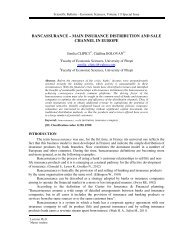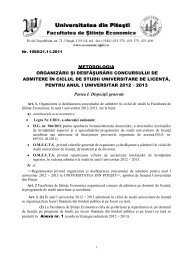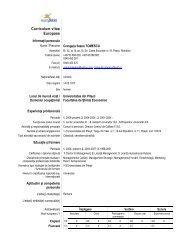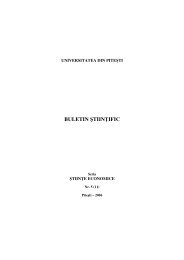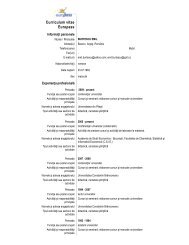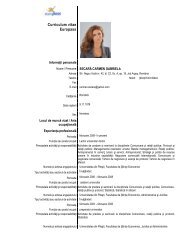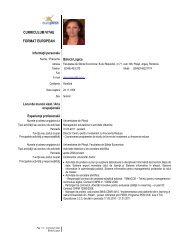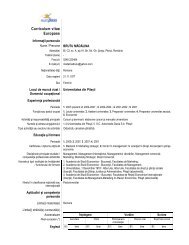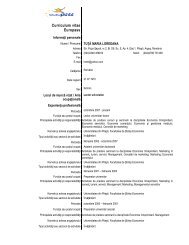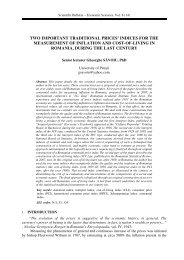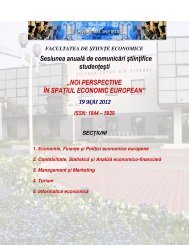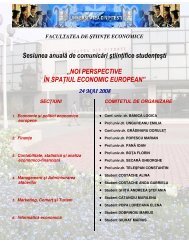buletin Åtiin ific - Facultatea de Stiinte Economice - Universitatea din ...
buletin Åtiin ific - Facultatea de Stiinte Economice - Universitatea din ...
buletin Åtiin ific - Facultatea de Stiinte Economice - Universitatea din ...
- No tags were found...
You also want an ePaper? Increase the reach of your titles
YUMPU automatically turns print PDFs into web optimized ePapers that Google loves.
Scient<strong>ific</strong> Bulletin – Economic Sciences No. 7 (13)Employment of labour in mo<strong>de</strong>ls of economic growthUniversity Lecturer PhD Cristina BÂLDANPhD Stu<strong>de</strong>nt Victoria- Mihaela BRÎNZEAFaculty of Economics, University of Pitestimihaelabranzea@yahoo.comAbstract:The economic growth resources represent the potential of useful mineral substances, ofhuman potential (population of working age), of scient<strong>ific</strong> research and the financialpotential of the society at a certain time. Resources are becoming economic growth factorsthat are used in or<strong>de</strong>r to <strong>de</strong>termine real possibilities of the society <strong>de</strong>velopment. Economicgrowth expresses a complex process of evolution over a long period, which is manifestedby an increase of the characteristic dimensions of a national economy. An economic growthsupposes not only an increase of production, but also an upward and sustainable movement.Keywords: Economic Growth, economic factors, labour1. General consi<strong>de</strong>rationsIntegration of labour within the economic mo<strong>de</strong>l was <strong>de</strong>veloped, to a certain extent, byclassical economists, who related it to the population as a prerequisite, but also as a restriction ofeconomic <strong>de</strong>velopments. The first complex mo<strong>de</strong>l of dynamic economic analysis is an extensivebree<strong>din</strong>g scheme <strong>de</strong>veloped by Marx, in which extensive bree<strong>din</strong>g problems of the workforce arecovered un<strong>de</strong>r the double aspect, quantitatively and qualitatively. However, the use of large-scalemo<strong>de</strong>ling of economic growth is more recent.In general, in terms of statistical-mathematical construction, mo<strong>de</strong>ls are distinguished inmonofactorial (monosectorial), multisectorial and bisectorial ones.In bifactorials mo<strong>de</strong>ls - preferred by the neoclassics, but also used by someneokeynesians - capital and labour inputs are treated as separate substitutable among themselveswithin certain limits. Both labour and capital are carriers and beneficiaries of technical progress.Bisectorial and monosectorial mo<strong>de</strong>ls have been exten<strong>de</strong>d to the multisectorial-mo<strong>de</strong>land although the complex construction involves difficulties in solving, they are usually rated asmore realistic.Usually, all mo<strong>de</strong>ls are monosectorial based type factors, relying on the assumption thatthere is a relationship of <strong>de</strong>pen<strong>de</strong>ncy among the results (Q), the aggregated factors - labour (L),funds production (K), and in some cases, natural resources:Q = f (L, K)In the analysis based on the production, macroeconomic bifactorial based production (Q)is the result of two key factors - labour (L) and capital (K) - as factors of production. Since anyrelation to the production inclu<strong>de</strong>s a spec<strong>ific</strong> <strong>de</strong>finition of technical progress, the EconometricMo<strong>de</strong>l is a mo<strong>de</strong>l reflecting growth <strong>de</strong>termined by the type and pace of this factor.Another feature of macroeconomic production function is that they assume as hypothesisthe <strong>de</strong>gree of utilization of labour, which in some cases is that of full employment.Starting from the Cobb-Douglas classical production function, numerous mo<strong>de</strong>ls havebeen <strong>de</strong>veloped, inclu<strong>din</strong>g factor based mo<strong>de</strong>ls, in which employment can be a restriction or aresult of economic growth.82




